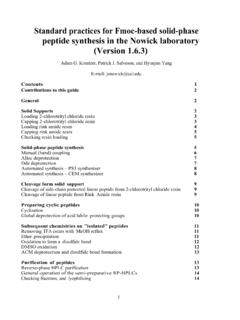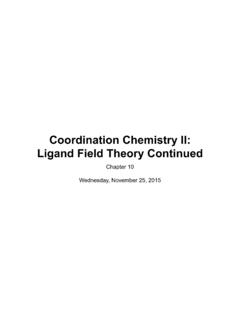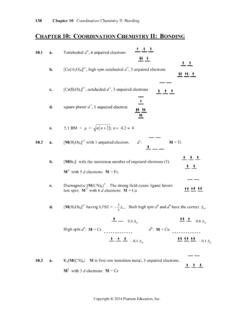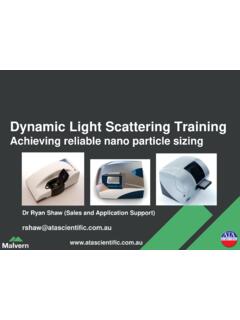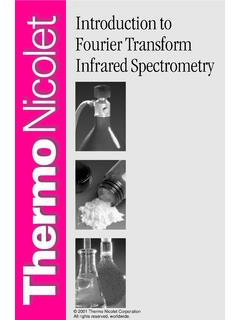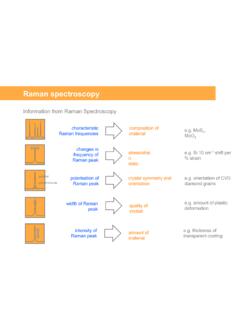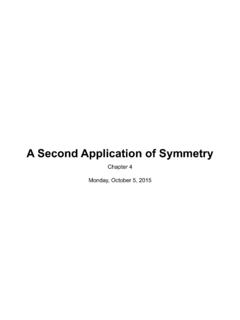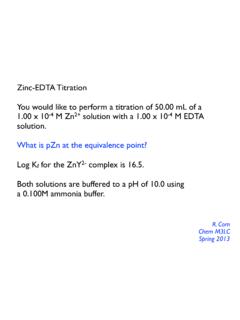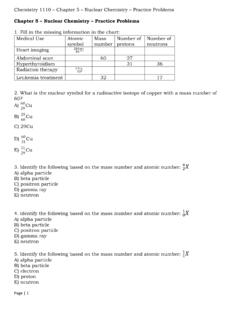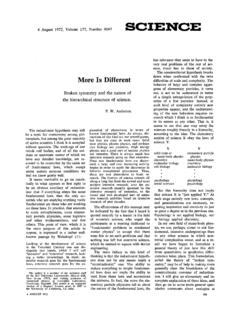Transcription of An Introduction to Fluorescence Spectroscopy
1 An Introduction to Fluorescence Spectroscopy 2 User Assistance PerkinElmer Ltd Post Office Lane Beaconsfield Buckinghamshire HP9 1QA Printed in the United Kingdom. Notices The information contained in this document is subject to change without notice. PerkinElmer makes no warranty of any kind with regard to the material, including, but not limited to, the implied warranties of merchantability and fitness for a particular purpose. PerkinElmer shall not be liable for errors contained herein for incidental consequential damages in connection with furnishing, performance or use of this material. Copyright Information This document contains proprietary information that is protected by copyright. All rights are reserved.
2 No part of this publication may be reproduced in any form whatsoever or translated into any language without the prior, written permission of PerkinElmer, Inc. Copyright 2000 PerkinElmer, Inc. Trademarks Registered names, trademarks, etc. used in this document, even when not specifically marked as such, are protected by law. PerkinElmer is a registered trademark of PerkinElmer, Inc. An Introduction to Fluorescence Spectroscopy 3 Table of Contents Table of 3 Luminescence and the nature of light .. 5 Fluorescence .. 7 11 Light scattering .. 14 Rayleigh-Tyndall scattering .. 14 Raman scattering .. 14 Quantitation .. 16 Sensitivity .. 18 Instrumental sensitivity .. 18 Method sensitivity .. 18 Absolute sensitivity.
3 18 Instrumentation .. 21 General .. 21 Light sources .. 22 Wavelength 24 25 Read-out devices .. 26 Sample holders .. 26 Problems of high blank 28 Cuvettes .. 28 Solvents and Reagents .. 28 Other 29 Working with dilute solutions .. 30 General .. 30 Adsorption .. 30 Photo-decomposition .. 31 Oxidation .. 31 Factors affecting quantitative accuracy .. 32 32 Temperature effects .. 32 pH 33 Inner-filter effects .. 33 33 References .. 34 An Introduction to Fluorescence Spectroscopy 4 An Introduction to Fluorescence Spectroscopy 5 Luminescence and the nature of light A hot body that emits radiation solely because of its high temperature is said to exhibit incandescence. All other forms of light emission are called luminescence.
4 When luminescence occurs, the system loses energy and if the emission is to be continuous, some form of energy must be supplied from elsewhere. Thus the radioluminescence emitted from a luminous clock face is supplied by high energy particles from the radioactive material in the phosphor and the electroluminescence of a gas discharge lamp is derived from the passage of an electric current through an ionised gas. Other such phenomena include chemiluminescence, derived from the energy of a chemical reaction, and this is called bioluminescence when the reactions take place within living organisms, for example, glow-worms and fireflies. When the external energy supply is by means of the absorption of infrared, visible or ultraviolet light, the emitted light is called photoluminescence and this is the process that takes place in any fluorimetric analysis.
5 To account adequately for the processes of absorption and emission of light, it is necessary to assume that radiant energy can only be absorbed in definite units, or quanta. The energy, E, carried by any one quantum is proportional to its frequency of oscillation, that is E = h = hc ergs where is the frequency, the related wavelength and h = Planck's constant ( x 10-27 ergs/seconds). The energy of a single quantum is too small for convenience and it is usual to talk of the energy associated with N quanta (where N = x 1023 the number of single molecules in a gram molecule), which is called an einstein. Thus, if in a photochemical reaction one molecule reacts for each quantum absorbed, then the absorption of one einstein is sufficient energy for the reaction of one gram mole.
6 Since the amount of energy per einstein is proportional to the frequency of the radiation, it varies enormously over the range of the electro-magnetic spectrum, as shown in the following table. An Introduction to Fluorescence Spectroscopy 6 Approximate sizes of Quanta Radiation (cm) (typical values) Wave- number ( m-1) Size of quantum (electron volts) Size of einstein (kilogram calories) Absorption or emission of radiation involves Gamma rays 10-10 106 x 106 x 107 nuclear reactions X-rays 10-8 104 x 104 x 105 Transitions of inner atomic electrons Ultraviolet Visible 10-5 4 x 10-5 8 x 10-5 101 x 10 1 x 102 x 101 x 101 Transitions of outer atomic electrons Infrared 10-3 10-1 x 10-1 Molecular vibrations Far infrared 10-3 10-2 x 10-2 x 10-1 Molecular rotations Radar Long radio waves 101 105 10-5 10-9 x 10-5 x 10-9 x 10-4 x 10-8 Oscillation of mobile or free electrons The ultraviolet and visible
7 Regions of the spectrum are of most interest in fluorimetry and absorption in these regions causes the excitation of the outermost electrons of the molecule. The energy associated with radiation of this frequency is quite high, around 100 kilogram calories per einstein, and is sometimes sufficient to break down the absorbing molecules, as for instance with the fading of dyes by the action of sunlight. The absorption of light results in the formation of excited molecules which can in turn dissipate their energy by decomposition, reaction, or re-emission. The efficiency with which these processes take place is called the quantum efficiency and in the case of photoluminescence can be defined as: ФE = einsteins emitted or No.
8 Of quanta emitted einsteins absorbed No. of quanta absorbed and never exceeds unity. An Introduction to Fluorescence Spectroscopy 7 Fluorescence At room temperature most molecules occupy the lowest vibrational level of the ground electronic state, and on absorption of light they are elevated to produce excited states. The simplified diagram below shows absorption by molecules to produce either the first, S1, or second S2, excited state (Figure 1). Figure 1 Transitions giving rise to absorption and Fluorescence emission spectra (10 10 sec) Vibrational Levels of second excited state Vibrational Levels of first excited state Vibrational Levels of ground state Rotational levels Fluorescence (10-9 10-6 sec) Internal (<10-12 sec) Conversion S2 S1 Absorption (10-15 sec) Absorption (10-15 sec) An Introduction to Fluorescence Spectroscopy 8 Excitation can result in the molecule reaching any of the vibrational sub-levels associated with each electronic state.
9 Since the energy is absorbed as discrete quanta, this should result in a series of distinct absorption bands. However, the simple diagram above neglects the rotational levels associated with each vibrational level and which normally increase the number of possible absorption bands to such an extent that it becomes impossible to resolve individual transitions. Therefore, most compounds have broad absorption spectra except for those where rotational levels are restricted (for example, planar, aromatic compounds). Having absorbed energy and reached one of the higher vibrational levels of an excited state, the molecule rapidly loses its excess of vibrational energy by collision and falls to the lowest vibrational level of the excited state.
10 In addition, almost all molecules occupying an electronic state higher than the second undergo internal conversion and pass from the lowest vibrational level of the upper state to a higher vibrational level of a lower excited state which has the same energy. From there the molecules again lose energy until the lowest vibrational level of the first excited state is reached. From this level, the molecule can return to any of the vibrational levels of the ground state, emitting its energy in the form of Fluorescence . If this process takes place for all the molecules that absorbed light, then the quantum efficiency of the solution will be a maximum, unity. If, however, any other route is followed, the quantum efficiency will be less than one and may even be almost zero.
